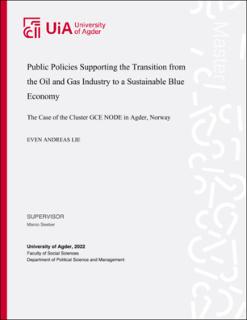| dc.description.abstract | In 2019, the European Union (EU) introduced a comprehensive strategy called the ‘European Green Deal’ to become the first climate-neutral continent by 2050. On the path toward this goal, several policy instruments have been introduced to reduce emissions by at least 55% by 2030, compared to 1990 levels (European Commission, 2019, p. 2-4). One of the primary sources of climate regulation toward this objective is within the oceans (Regjeringen, 2017, p. 102). Therefore, a transition to a sustainable blue economy can be an essential climate measure and an important new source of income for Norway (Regjeringen, 2021a). As the oil and gas industry is one of the primary ocean industries in Norway and the most profitable relative to value creation, the region of Agder has developed world-leading competence in the supplier industry for the oil and gas industry (Forskningsrådet, 2020). This puts Norway and the region of Agder in a good position for the transition to a sustainable blue economy (Regjeringen, 2017, p. 7).
But which policy instruments produced at the multinational (EU), national (Norway) and regional (Agder) levels are currently the most important in supporting the transition from the oil and gas industry to a sustainable blue economy?
To explore what role public authorities at the various levels play in this transition, document analysis is used, and a semi-structured interview with an informant from the industry-driven cluster GCE NODE is conducted. The document analysis includes an analysis of the policy instruments introduced by categorizing them using the NATO Taxonomy developed by Hood & Margetts (2007).
The result shows that the EU lay the basis for this transition by legislating the objective of becoming a climate-neutral society by 2050 in the Climate Law. Norway has also committed to this transition by legislating the aim of the EU in the Norwegian Climate Change Act. The region of Agder will facilitate this transition through increased investment in research, development, and innovation, focusing on project development and developing collaboration forums with relevant actors to gain increased knowledge and competence on the potential of a sustainable blue economy. | |
